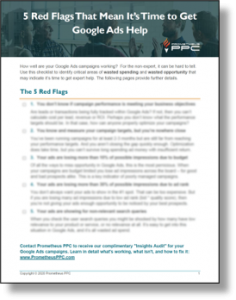AI for Google Ads Lead Generation: 3 Good Uses and 3 Costly Mistakes

It’s a hot topic — How to best leverage AI for Google Ads. The do’s and dont’s. The tricks and traps. And the possibilities are of course fast-changing.
So before we dive into our 6 high-priority topics, here are two caveats:
Caveat #1: My agency has observed these best practices as of May 2024. They will certainly change again soon!
Caveat #2: I am using “AI” to mean both true Artificial Intelligence-based learning systems and sophisticated automation tools. For such tools a company may claim “AI-based” such and such, but it would be beyond the scope of this post to sort it all out.
[Full disclosure: I of course used AI (ChatGPT-4/DALL-E) to create the image above!]
Further, this post is focused on using AI for high-value lead generation within Google Ads. That’s a different beast from advertising low-cost services or products.
With that, let’s jump in!
3 Effective Uses of AI for Google Ads Lead Generation
#1) Using AI for Automated Bidding
This one may seem obvious, but it also contains the seeds of your demise if you’re not careful (see Mistake #1 below).
First of all, you should use some form of Google Ads’ automated bidding for any lead generation. It would be negligent not to. We humans can analyze campaign performance looking at one or a few variables at a time. Google’s system can analyze hundreds of signals at once including:
- Real-time user data: demographics, audience memberships, etc.
- Real-time search data: the exact query, time of day, device, location, competition, etc.
- Historical data: How all of the above has played out before, with more recent conversion performance more heavily weighted
Google will sort all that data to select the best ad group, ad content and landing page to use for each unique auction.
It is not possible for even the best Google Ads human expert to weigh all those factors appropriately. And forget about trying to set custom bids for each auction within milliseconds.
You might ask, what about 3rd party tools? Yes, there are some out there that claim to offer superior bidding capabilities to Google’s. You can plug them into your account via the Google Ads API. Personally, I wouldn’t give them a second look, for two fundamental reasons. To me these are show-stoppers:
a) They cannot access all of Google’s data
b) They cannot match Google’s multi-billion dollar investment in AI-based bidding
With that cleared up, what are your best options for using Google Ads’ automated bidding for high-value lead generation?
With conversions as your goal, here are your best options:
1. eCPC (Enhanced CPC) bidding – You set a Max CPC (Cost Per Click) bid for each keyword, just like in the good ol’ days. Then, the “enhanced” option lets Google’s AI raise or lower that bid if it determines that a particular auction is more or less likely to lead to a conversion. This option gives you the most control over bids, but also gives you the least benefit from Google’s AI. Yet if your account has low spend and/or search volume, this is often the only option that will work.
2. Maximize Conversions bidding – You set a budget, and Google’s AI will try to get you as many conversions as it can. Note: With this bid strategy, Google will do everything possible to spend your full budget (or more). That might be a terrible idea if you set a daily spend that is higher than what can reasonably be supported by good leads. Google will be happy to work really, really hard to spend every last penny of your budget on getting more bad leads, if that’s all it can find. With this bid strategy you also can’t set Max CPCs, so don’t be surprised if you see some individual clicks costing you north of $100.
3. tCPA (Target CPA) bidding – this is akin to “Maximize Conversions” but you set your target cost per conversion (CPA). You can also set a Max CPC. Both of these features help keep the automation from running off the rails. Use this instead of “Maximize Conversions” whenever you can. But you do need to have an idea of reasonable CPA targets for your campaigns. If you set them poorly, the campaigns will either underperform, or give up and stop spending.
4. Maximize Conversion Value bidding – If you can assign reasonably accurate values to each of your Conversion actions, then you can upgrade “Maximize Conversions” to “Maximize Conversion Value”. This is important when individual Conversions can have very different value to your business. You ideally want Google to spend more effort on getting high-value Conversions. Without value information, Google will happily go after the easiest Conversions for it to get. Surprise surprise, those are often the lowest value ones. Note that this bidding algorithm has the same important shortcomings of “Maximize Conversions” — it will happily blow through your entire budget even if it provides zero conversions, and you can’t cap CPCs.
5. tROAS (Target ROAS) bidding – this is akin to “Maximize Conversion Value” but you set your target Return on Ad Spend (ROAS). You can also set a Max CPC. Both of these features help keep the automation from running off the rails (as with tCPA). This is the ultimate Smart Bidding strategy as it takes into account everything it can about Conversion quantity, quality and ROI needs. It does, of course, require that you have an idea of reasonable ROAS targets for your campaigns. If you set them poorly, the campaigns will either underperform, or give up and stop spending.
The bid strategies higher up the list work with less search volume and data (often the case for high-value lead generation). The ones lower down the list work the best if you have high search volume and complete data. Be sure to consider all the trade-offs.
#2) Using AI for Brainstorming
LLMs like ChatGPT and Google’s Bard are great for brainstorming. They are just like your personal assistant, Joe. That is, if Joe could call a whiteboard brainstorming session with the entire world in the room and distill the findings within seconds. Good luck with that, Joe!
Even better, use two LLMs and get two sets of globe-spanning research summarized in seconds. I often use ChatGPT-4 and Bard simultaneously. They give interestingly different answers that I can combine to produce better final results.
What can they help you brainstorm for your Google Ads account? Critical elements such as content for ads and ad extensions, keywords, audiences and more.
Ask questions like:
- “What are more professional (or more compelling, or more clever, or more hip) ways of saying XYZ?”
- “What do people search for online when they need XYZ?”
- “What are important buying considerations for businesses (or consumers) who need XYZ?”
- “What sorts of people typically pay for XYZ?”
- “What businesses (or consumers) likely spend the most on XYZ?”
- “What does ABC company (your competitor) say when they advertise XYZ?”
Tailor these questions further to the particular lead generation needs of your business. For example, “What are the characteristics of people who have more than $5 million saved for retirement?” Or, “How can we best promote our architecture firm to homeowners who would also need our construction partners?”
But in all cases, of course, do NOT blindly cut and paste LLM output into your account. Brainstorming is just that — generating ideas. You still need to do the hard and very important work of distilling those ideas. You need to create the effective ad copy, useful keywords, and relevant audiences that make the most sense for your business and goals.
Note that Google Ads now offers AI-generated ad content suggestions in real time while you are creating ads. Here too, you must apply your own knowledge. Google only know what it sees in your keywords and ads and what it reads on your landing page. If some of that targeting or copy isn’t on-target, then the ideas it generates won’t be either.
#3) Using AI to Catch Errors
Google Ads is immensely complex. This is why it’s powerful. And why it’s easy to make mistakes.
There are so many ways for errors to creep into an account. You might mis-form keywords. Or have negative keyword conflicts. Or accidently target users outside your targeted locations. Or have type-o’s in your ads. Or forget to enable ad extensions for new campaigns. Or accidentally pause all ads in some ad groups. Or make a seemingly small change that doubles your ad spend. I could spend a day just listing errors. Here, too, you can expect only so much from fallible humans.
This is why it’s essential to employ smart, automated error-checking. Google Ads itself does some of this. There are various 3rd party tools that do much more. In my agency we use Adalysis for this error checking. Note that I don’t have any relationship with Adalysis other than being a long-term happy user. We also like it for its valuable A/B ad testing significance analysis.
Regardless of your tool preference, make sure that you have sufficient automated checks in place to help keep your account on track.
So, those were 3 effective ways to use AI today for your high-value Google Ads lead generation. What about the ways NOT to use AI?
3 Costly Mistakes When Using AI for Google Ads Lead Generation
#1) Using AI-based bidding without good data
Have you heard the computer science phrase, “Garbage in, garbage out”?
When we take over management of an account, we very often find garbage going into it. I.e., the Conversion tracking is incomplete or innacurate. Usually it’s both.
We recently started working with a new advertiser who had two main Conversion actions in use in his account. One correctly tracked value, but someone had assigned a wildly inflated fixed value to the other. The advertiser was working with Google’s Accelerated Growth team, which recommended a sharp increase ad spend because the early ROAS results were so good.
The end result? Google’s Smart Bidding spent most of the enlarged budget going after that high fixed-value Conversion action. The Conversion Value and ROAS metrics looked fantastic. But at the end of the month the advertiser realized that over 80% of the Conversion “value” was a phantom. This made the extra ad spend completely unprofitable. They took a big loss because Google’s AI did exactly what it was supposed to do, but with garbage going in. (Not surprisingly, the Google rep neither apologized for the bad advice nor offered a refund of the ad spend.)
How to avoid this mistake: Before using any Smart Bidding, and before scaling up ad spend, be sure your Conversion tracking is both complete and accurate. This can be complex, technical and time-consuming. It is also 100% necessary.
#2) Using AI-based budget recommendations
There are several Google Ads tools that recommend budgets for your campaigns using “AI-based predictive analysis”. In nearly all cases we have found such recommendations to be extraordinarily high. Usually, they should simply be ignored. Why? A couple of reasons.
First, Google’s tools, help pages, support team and overall ecosystem are biased towards getting you to spend more of your money on ads. This should come as no surprise to anyone since most of Google’s own revenue comes from ad revenue.
Second, Google’s budget recommendations look primarily at potential search volume and ad exposure. There is always more search volume to go after, and you can always bid for higher ad placements, and the algorithm is delighted to show you how to do all of that. But what if you need a certain CPA or ROAS to make advertising profitable for your business? The algorithm doesn’t know anything about your specific business needs.
If you simply follow Google’s recommended budgets, you will often find that you have pushed well past the point of diminishing returns. Your costs escalate, and your profit plummets.
How to avoid this mistake: Always set your budgets to meet your business objectives, NOT to meet Google’s “AI-based” recommendations.
#3) Using AI-based audience expansion
Google has multiple ways of expanding your audience targeting without you being aware. If your auto-apply settings allow it, Google’s AI can auto-create new audiences that it thinks are similar to your current audiences. It can also then auto-apply them to active campaigns. Additionally, there is a setting for “audience expansion” that is applied by default to audiences that you target. All this means that you could be showing your ads to groups of people far beyond what you intended.
We have seen this most egregiously in Display Remarketing campaigns. Another advertiser who brought us on to manage their account wanted to show Display ads only to their past website visitors. This is a common practice because past website visitors make up a somewhat qualified audience. But because of the “audience expansion” setting, less than 2% of the budget was spent to show ads to those past website visitors. Over 98% was spent to show ads to a much broader set of people who had never visited their website at all but who Google’s AI thought were “similar” enough. Not surprisingly, the Remarketing campaign spent a lot of money for very few leads.
The use of AI-expanded audiences, especially without your awareness, is a great way to waste a lot of money.
How to avoid this mistake: Always double-check the audiences being targeted by your campaigns and the audience expansion settings being applied. Also check your account’s “auto apply” setttings and disable all those that you don’t want, which should be most of them.
Summary
AI is here to stay, of course, and it will only get more powerful and more pervasive. That doesn’t mean it will always make good decisions for your Google Ads lead generation. AI doesn’t (and can’t) understand your specific advertisting objectives and business needs.
This problem is even harder for high-value lead generation. This type of advertising usually involves lower search volume and fewer conversions. That means less data for Google’s AIs to train with.
Be sure to keep on top of these 3 big opportunities and 3 big money wasters. And feel free to reach out to us if you think you might benefit from expert Google Ads help.


Hi Andrew,
Those are some nice use cases of AI for Google Ads. But I am still afraid of using AI for Bidding. I prefer using it for only for brain storming consider that a mistake can lead to failed campaigns.
I have long shared your concern, Avinash. We slowly transitioned from Manual CPC bidding to Enhanced CPC bidding to full “Smart Bidding” slowly over the years as we gained confidence in it from hard data. We ran split tests and committed to more automated bidding only after seeing clear, measurable benefits.
Even now, though, that isn’t always the case. In about 20% of our client accounts we still use CPC or eCPC bidding because every time we run a split test with Smart Bidding the Smart Bidding performs worse. But I do expect it will continue to get better.
All good points Andrew. I’d add the following:
AI can be deployed to to effectively carve out STAGs (Single Theme Ad Groups) wherein you can dump a raw list of shortlisted keywords taken from Google Keyword planner or SEMRush and it can quickly create “AI clusters” which can be used as STAGs.
We use https://speedppc.com/ tool for this. (No affiliation, recommending them based purely on quality)
AI can be deployed for quickly creating custom graphics. We use the Canva AI generator https://www.canva.com/ai-image-generator/ for this. Decent enough without the complexities of Dalle or MidJourney.
AI can be deployed for quickly generating Video assets. https://invideo.io/make/ai-web/ (again no affiliation)
These are significantly better than Google ad’s inbuilt AI assets capabilities.
When it comes to mistakes, I think you’ve covered the most important ones already.
I’d add blindly trusting AI recommendations aimed at strengthening the OptiScore of the campaign can potentially benefit Google more than the client.
For example: AI can recommend adding a lot of broad match keywords which could be upper funnel; but if your campaign is primarily targeting the bottom of the funnel and if one has a budget cap, then the AI recommendation has to be carefully assessed whether it aligns with the overarching strategy.
Hi Yatin,
I appreciate your well thought-out comments. Those look like some useful tool recommendations. And I agree that everyone should be careful in applying Google’s “Optimization Score” recommendations. They are generic and aimed at getting advertisers to use all available campaign options, which tend to increase ad spend. But many of those options, as you pointed out, can run counter to actual business objectives, particularly for lead generation quality.